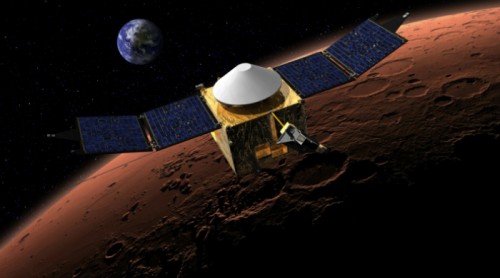The American spacecraft Maven that took off yesterday will investigate why the atmosphere of Mars has disappeared

Millions of years ago, the surface of Mars was not much different from that of the early Earth: oceans, rivers and a water cycle including clouds and precipitation. The atmosphere of Mars also resembled ours, if not in terms of composition, at least in terms of density and the effect on the water cycle. However, since then a lot of water has passed over Mars: the planet's atmosphere became thinner and thinner, until it disappeared almost completely. As a result, all the liquid water on its surface evaporated, and Mars became an arid desert. Why did this happen, and how did the atmosphere of a planet relatively similar to Earth evaporate? On this, the American space agency hopes to get answers from the "Maven" spacecraft (MAVEN, short for Mars Atmosphere and Volatile Evolution), which is supposed to leave this evening on the long way to Mars. "The spacecraft will investigate the evolution of the atmosphere of Mars, especially in the upper layers, and try to understand why a significant part of the atmosphere escaped into space. The atmosphere of Mars is very, very thin - about 1/200 of the density of our atmosphere," explains Prof. Yoav Yair, from the Department of Natural and Life Sciences at the Open University. "We hypothesize that Mars and the Earth were formed under the same conditions, therefore it is very intriguing to understand why a significant part of the atmosphere of Mars escaped into space."
Not only on Mars
In addition to the scientific puzzle of what is happening in our closest neighbors, the answers that MAVEN will provide may also explain to us processes that occur in our atmosphere. "It is possible to understand from the processes that occur between the solar radiation and the high atmosphere on Mars, things that also occur here," says Yair. "It's not like we'll lose our atmosphere tomorrow morning. Although we have inventory in the ground, it is very important to understand what happens between the sun and the atmosphere, and how it affects the chemical composition of the atmosphere."
Preparation for settlement
If everything goes well, Mayvan will reach Mars in ten months, and will circle it at a variable altitude, between 125 and 6,000 km. Its instruments will sample the composition of the atmosphere at different altitudes, in different regions and at different times of the year, in order to try to tap into the distant past from the differences between them. Her mission should last about one country year, with the possibility of extension.
The American spacecraft launches about two weeks after India launched a similar research spacecraft of its own to Mars. When both reach their destination, in September 2014, no fewer than five satellites will circle around Mars, in addition to the two active probes that are still investigating the surface. A significant part of the missions deal with preparations for the ultimate mission, landing a man on Mars one day. Maven's findings may also be of great importance. "If you want to establish a long-term settlement on Mars, you need to understand what resources the atmosphere allows us," explains Yair. "You have to understand, for example, if it picks up dust, and if it is electrified. What chemical compounds can be produced from it. Is there, for example, methane in the atmosphere, and can fuel be produced from it? There are many practical questions that the settlers will want to know the answers to."

One response
I read that it is because of the poor magnetic field that Mars has.